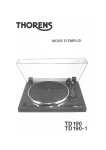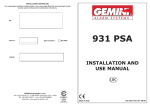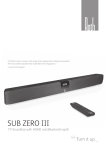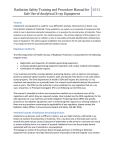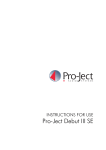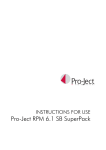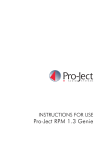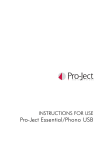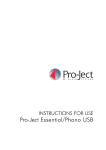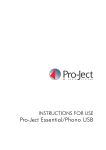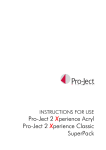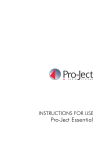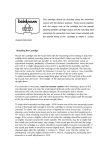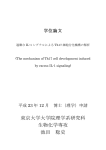Download 6 - Brionvega
Transcript
RR-226_UK.indd 1 21-11-2008 12:09:51 1 Radio-phonograph general information 9 8 10 7 1 6 11 2 5 18 17 12 16 13 15 3 14 4 19 27 26 rr- 2 26 28 MODELLO DEPOSITATO radiofonografo MADE IN ITALY ANTENNA IN AUX 1 PRE OUT AUX 2 SUB CUFFIE DX DIFFUSORI SX 20 INTERRUTTORE GENERALE 0 0 1 ALIMENTAZIONE 230V 50Hz I 25 21 22 29 23 24 2 RR-226_UK.indd 2 21-11-2008 12:09:53 i The Radio-phonograph rr-226 is a high-fidelity stereo system with stereo record player. It is composed of a central part which contains the radio receiver, amplifier, record player, CD MP3 player, control panel and connection panel, and 2 compression loudspeakers that can be fixed to the central part or arranged in the best position to improve the stereo effect. 1 Record player cover 2 CD - MP3 Player 3 AM-FM Radio frequency scale 4 AM-FM Radio stored station scale 5 Loudspeakers 6 Record player 7 Stored station selection knob 8 Red stored radio station LED 9 Green power LED 10 Sound level indicator 11 Radio station selection knob 12 ON/OFF - Volume Level knob 13 Bass adjustment knob 14 Support stand 15 Middle tones adjustment knob 16 Treble adjustment knob 17 Audio balance adjustment knob 18 Control push-button panel 19 Loudspeaker carrying handle 20 Loudspeaker side fastening bracket 21 Audio outlet holes 22 Auxiliary audio inputs (AUX1 - AUX2) 23 Loudspeaker connections panel 24 Main switch 25 Mains socket 26 Central unit ventilation holes 27 Audio connection for external subwoofer 28 Pre-Out audio output 29 Headphone socket 3 RR-226_UK.indd 3 21-11-2008 12:09:55 2 Important safety rules Danger of electrical shock Do not open the appliance Always refer to the documentation or a service centre • • • • Carefully read and follow the instructions provided. • Clean the product using only a damp cloth. • Transport the product using the appropriate protective packaging. • Keep the original packaging of the product in case repairs are required. • Do not connect the appliance to the mains electricity if the plug and/or cable [19] are damaged, but contact your nearest Technical Service Centre. • Do not leave the appliance connected to the mains electricity when you are away for long periods. • The appliance should be positioned near the power outlet, and the power supply cable [19] should be easily accessible to facilitate disconnection if necessary. Arrange the power supply cable [19] so that nobody will trip over it. • Do not insert objects inside the appliance. • • Do not remove the back cover of the appliance; the highvoltage current inside may cause electrical shocks. • Do not position the appliance in damp areas or areas where it may be exposed to vapours or water splashes. • Do not place the appliance near sources of heat such as radiators, stoves or appliances that produce heat. • Do not place the appliance in a confined location, but ensure that there is sufficient space (minimum 10 cm) • • all around it for ventilation. The air vents must be left free in order to allow cooling of the internal electronics. Do not have checks or repairs carried out by nonspecialized personnel, but always use the Brionvega authorized Technical Service Centres. No naked flame source, such as candles, should be placed on the apparatus. No object filled with liquid, such as vases, shall be placed on the apparatus. An excessive sound pressure from earphones and Headphones can ‘cause loss of hearing. 230 Vac, tolerance + / - 10% (48 to 62 Hz); Net absorption: (can ‘be the current 300mA or the power 30 W). • Carefully read all the chapters of this manual before operating the product. This manual provides the basic instructions for operating the rr-226 system. The installation, preliminary adjustments and procedures that require opening the units and contact with the electrical parts must be carried out by qualified personnel. To ensure safe and reliable operation over time, use only the power supply cables supplied by the manufacturer. Observe all the precautions and warnings. • Consult the environmental standards at the end of the instructions booklet for more information on the disposal of the product and protection of the environment. 4 RR-226_UK.indd 4 21-11-2008 12:09:56 3 Installation instructions Power supply Loudspeakers The Radio-phonograph rr-226 operates with an AC power supply. The main switch [24] and the mains socket [25] for connecting the power supply cable are located on the back panel. The Radio-phonograph rr-226 is equipped with 2 compression loudspeakers that should be connected to the audio sockets [23], located on the back panel of the appliance. 0 1 + + The loudspeakers can be located in three different positions: rr- 2 26 MODELLO DEPOSITATO radiofonografo MADE IN ITALY ANTENNA IN AUX 1 PRE OUT AUX 2 SUB CUFFIE DX DIFFUSORI SX INTERRUTTORE GENERALE 0 0 1 ALIMENTAZIONE 230V 50Hz I 1. On the top part of the radio-phonograph, using the appropriate support guides. In this position it will not be possible to access the control keypad of the CD-MP3 player and the record player unit. ! Caution: Before connecting the power supply cable to the mains socket, make certain that the main switch is in position (0). Then power the radio-phonograph by moving the switch to position (I). 2. On the sides of the Radio-phonograph, using the appropriate interlocking fastening brackets. 5 RR-226_UK.indd 5 21-11-2008 12:09:57 3 Installation instructions 3. In this position, all the controls of the Radiophonograph can be used and at the same time the increased distance between the two loudspeakers guarantees a good stereo effect. Record player island Removal of the adhesives fastening the island 1 4. The 2 loudspeakers can also be positioned further from the central body of the Radio-phonograph. Since the connection cable of the loudspeaker will have to be extended, however, take care not to invert the two conductors and the power supply poles. 01 15:10 3 2 Fastening the loudspeakers on the sides To prevent vibrations from propagating while a record To position the loudspeakers on the sides of the cen- is playing, the record player unit of the Radio-phonotral unit, hook the loudspeaker to the body of the graph is fixed above a platform (3) which is detached Radio-phonograph using the interlocking bracket from the entire structure of the Radio-phonograph. already present on inner side of the loudspeaker. ! Caution: Ensure that the coupling is secure before releasing the loudspeaker in order to prevent it from falling. Before using the Radio-phonograph, remove the adhesives 1 and 2 (indicated in the figure) fastening the record player island. Once the adhesives have been removed, if the Radio-phonograph should tip over, the record player island may be mobile. 6 RR-226_UK.indd 6 21-11-2008 12:09:59 4 Connections panel Audio Connections Pre-Out Output The Radio-phonograph rr-226 is equipped, on the back, with an audio connections panel. Using the Pre-Out audio output [28] an external amplification device can be connected to the Radio-phonograph. If an external amplifier is connected, the loudspeakers of the Radio-phonograph will continue to sound. To disable them, it will be necessary to disconnect the loudspeakers from the audio connections panel [23] located on the back of the Radio-phonograph (see page 5). The volume control knob will have no control over the signal level coming out of the Pre-Out connection [28]. AUX 1 PRE OUT AUX 2 SUB CUFFIE Aux 1-2 Input RADIO AM-FM AST PHONO Headphone Socket CD AUX1 AUX2 LOUD Using the Aux 1-2 input [22], an external audio reproduction device can be connected to the Radio-phonograph, using the Radio-phonograph as an amplification system. In order to be able to listen to the external audio source, it will be necessary to activate the specific function on the front push-button control panel (push button AUX1 or AUX2). In addition to the volume adjustment, the knobs for the audio level adjustments will also remain functional. Using the Headphone Socket [29], a pair of headphones or earphones can be connected to the Radio-phonograph. When the connection jack is inserted, the audio of the loudspeakers will automatically be disabled. Sub Output Using the Sub audio output [27], a supplementary preamplified subwoofer can be connected to the Radio-phonograph. 7 RR-226_UK.indd 7 21-11-2008 12:10:00 5 Using the radio functions 2. Turn the knob [11] until you find the desired radio station. 3. Press the knob [7] to store the radio station. Turn on the appliance by turning the volume control 4. The red LED [8] will flash to confirm that the radio knob [12] clockwise. station has been stored. The 2 needles [3 and 4] will remain positioned on the last radio stationed tuned in at the time the appliRepeat the operations described above for all the ance was turned off. other stations you would like to store. Preliminary operations The Radio-phonograph has a push-button control panel on the front that allows the user to manage the various audio sources and radio frequencies as well as make some adjustments on the sound quality. Using the control keypad, select the function RADIO and the desired frequency [AM-FM]. RADIO AM-FM AST PHONO CD AUX1 AUX2 FM Reception In addition to the previous station search mode, another two modes are possible for FM reception: LOUD Automatic search and storage: 1. Using the control keypad [18], select the function AST to activate the automatic search. Tuning the radio stations Press the [AM-FM] button to select the type of reception/band desired The system searches for the radio stations and automatically stores them in programmes 13 to 24 on the programme scale [3]. RADIO AM-FM AST PHONO CD AUX1 AUX2 LOUD - FM allows the user to store 24 programmes - AM allows the user to store 5 programmes 1. Use the knob [7] to select the programme number to be assigned to the station. - The search occurs in several passes, tuning in first the strongest stations and then the weaker ones. 8 RR-226_UK.indd 8 21-11-2008 12:10:00 Using the radio functions 5 ! - The automatic storage reserves programmes 1 to 12 for your favourite stations. Semiautomatic search: 1. Press the knob [11] for about 2 seconds: the tuning system activates and stops at the first station it finds. If the station is already stored, the red LED [8] on the front of the Radio-phonograph becomes steady-on. If the station has not be stored previously, the red LED flashes. 2. To store the station, select the programme number on the scale [4] with the knob [7] and then press the knob [7]. Continue in this manner to find and store the other stations. Once these tuning operations have been completed, you can turn the knob [7] to select the programme associated with your preferred radio station and begin listening to it. Turning off the radio To turn the radio off, turn the knob [12] anticlockwise until a click is heard and the reference mark is positioned on OFF. 9 RR-226_UK.indd 9 21-11-2008 12:10:01 6 Using the audio functions Record Player - CD/MP3 Player The Radio-phonograph rr-226 is equipped, on the top, with a CD-MP3 player [2] and a record player [6] able to play 33 and 45 rpm records. CD 01 15:10 Turn on the appliance by turning the volume control knob [12] clockwise. Using the control keypad [18], select the function CD or the function PHONO in order to listen to the desired audio sources. RADIO AM-FM AST PHONO CD AUX1 AUX2 LOUD CD / MP3 Player The CD-MP3 player [2] of the Radio-phonograph rr226 is a “Slot Loading” player. To insert the CD, just let it slide into the slot and the player will independently position the CD in the playing position. The CD/MP3 player automatically recognizes if the CD that has been inserted is an audio CD or an MP3 CD. On the top left part of the display the text CD or MP3 will appear depending on the type of disc being played. 1 2 3 4 5 6 7 8 9 10 1 CD ejection button Pressing this button automatically ejects the CD contained inside. 2 CD-MP3 option. Indicates the type of CD inside the player. 3 CD player multifunction display. 4 Slot for inserting the CD. 5 Play Button (to start playing the CD) 6 Stop Button (to stop playing the CD) 7 Back Button (to go back to the previous soundtrack) 8 Fast Back Button (to go back within the soundtrack) 9 Fast Forward Button (to advance within the soundtrack) 10 Forward Button (to advance to the next soundtrack) If the MP3 CD is divided into several folders, the display will show the number of the folder to which the soundtrack currently being played belongs. To move from folder to folder, use the button [7] of the CD player. After the last soundtrack of each folder, the player will automatically jump to the first soundtrack of the next folder. 10 RR-226_UK.indd 10 21-11-2008 12:10:01 6 Using the audio functions Record player 1. Adjust the contact force of the stylus: The record player on the top of the Radio-phono- Taking care not to damage the stylus, carefully pergraph rr-226 is manually operated. form the following operations: It does not have either the automatic initial positioning of the stylus or the automatic arm return after the 1. lower the arm lifter [C] and hold the arm in equirecord has finished playing. librium with your finger. 2. set the antiskating [A] to zero (take the small Handle the arm and stylus of the record player weight off the support and rest it on the record with care. Do not allow the record player stylus player surface so that the weight does not proto continue moving after the record has finished duce any tension on the arm). playing, in order to avoid damaging or breaking the stylus. ! Reference notch Before using the record player [B] Before using the record player, some important operations must be carried out to set the forces acting on the operation of the record player arm. To perform the following operations: [C] 1. Remove the plastic cover of the record player [1]. Be careful not to strike the arm or the stylus. 2. Make certain that the power switch of the record player is in the OFF position (0) and that the turntable is not rotating when setting the forces. [A] 3. To perform a correct setting of the arm, ensure that the Radio-phonograph is on a level surface free of 3. At this point rotate the counterweight [B] until the inclinations or unevenness that may invalidate the arm rests perfectly in equilibrium by itself, in the arm setting. space between the turntable and the retainer of the arm. The position assumed should be perfectly horizontal. 11 RR-226_UK.indd 11 21-11-2008 12:10:01 6 Using the audio functions 4. Rotate the numbered ring nut of the counterweight until the zero lines up with the reference mark on the stick of the arm. Value [0] of the ring nut aligned with the reference notch pending on the state of wear of the head (the newer it is, the greater the weight necessary, at least initially), the room temperature and the type of sound you would like to obtain. It should be remembered that very low contact forces produce more damage than larger contact forces. In fact, the smaller the contact force is, the more free the stylus will be to skip about among the grooves, destroying them. In terms of sound quality, a larger weight increases the bass tones and softens the sound while a lower weight shifts the timbre balance upwards, increasing the sensation of fast and dynamic sound. 2. Adjust the antiskating force: Now it will be possible to set the antiskating force, normally of the same value as the contact force, but this is also highly variable and should be evaluated by ear. The antiskating force opposes the centripetal force that tends to attract the head towards the centre of the record. A correct setting of the antiskating force is achieved when, observing the stylus while reading the Now it is possible to correctly set the contact force grooves, the stylus remains in axis with the body of the required for the head being used. head without being pulled either inward or outward. ! With the standard head, it is recommended that you set the contact force to the value of 17.5 mN (1.75g). The reference ratio for calculating the contact force and then the antiskating force is the following: 1mN= (= 0.1g / 0.1 Pond). i Remember that the force indicated by the head manufacturer is, in fact, only indicative, and the actual value may differ by plus or minus 0.5 grams de- To set the antiskating force correctly, proceed as follows: 1. Reposition the weight and respective string inside the appropriate guide. 12 RR-226_UK.indd 12 21-11-2008 12:10:01 6 Using the audio functions 2. Set the antiskating force by changing the contact point of the string on the appropriate graduated pin. wires in order to limit the propagation of vibrations and guarantee an ideal tension on the drive belt. During shipping, however, the motor is anchored to the structure by 2 screws. It is recommended that you save the 2 clamping screws for future use in case of the Radiophonograph rr-226 must be transported again. For best use of the record player, the 2 screws should be removed following the procedure below: 1. Lift the record player turntable by pulling it upwards. 2. Unscrew the 2 screws indicated in the figure so that the motor is free to oscillate. 3. Return the record player turntable to its initial position. The simple table below shows the antiskating force setting corresponding to the contact force applied. Vertical contact force Antiskating force 10mN - 14mN (1g - 1.4g) Position 1 15mN - 19mN (1.5g - 1.9g) Position 2 20mN or greater (2g - >g) Position 3 1 2 ! With the standard head, it is recommended that you set the antiskating force on position 2, i.e., with the following values: 15mN - 19mN (1.5g 1.9g). 3. Releasing the motor Before starting the record player turntable, the motor must be released from its clamping supports. The motor of the Radio-phonograph rr-226 record player is supported by a system of elastic tension Be careful not to damage the surrounding structures with the screwdriver while removing the clamping screws. 13 RR-226_UK.indd 13 21-11-2008 12:10:02 6 Using the audio functions Starting the record player Once the arm setting procedure has been carried out, you can start playing a record. To start the record player, follow the procedure below: 1. Position the record on the turntable of the record player using the felt provided. 2. Move the record player switch to position (1). The turntable will begin to rotate. 3. Position the stylus on the desired track and, using the arm lifter lever, lower the stylus onto the record. 33-45 rpm settings The record player of the Radio-phonograph rr-226 can play 33 and 45 rpm records. To change the speed of the record player turntable, follow the procedure below: 1. Lift the record player turntable by pulling it upwards. 2. Use the key (included) to move the drive belt from one motor pulley to the other. 3. Reposition the record player turntable. The larger pulley is for playing 45 rpm records, while the smaller pulley is for playing 33 rpm records. The record player of the Radio-phonograph rr226 is not able to play 78 rpm records. 14 RR-226_UK.indd 14 21-11-2008 12:10:02 7 Adjusting the Sound levels Adjusting the sound The sound level controls are located in the centre of the front panel on the Radio-phonograph rr-226. The following levels can be adjusted by the user: 1. Volume Level [12] The listening volume can be increased or decreased using the knob [12]. Rotating the knob completely in the anticlockwise direction will turn the Radiophonograph rr-226 off. 4. Loudness [PUSH-BUTTON PANEL 18] The button to activate the Loudness function is located on the push-button control panel. RADIO AM-FM AST PHONO CD AUX1 AUX2 LOUD The Loudness function has the purpose of compensating the weaker sensitivity of the ear, especially to low frequencies, when the system is used at a low volume. Its function increases the frequency response of the amplifier. 2. Bass - Middle Tones - Treble Level [13] [15] [16] The levels of these three sound frequencies can be controlled using the knobs [13], [15] and [16]. Rotate the knob clockwise to increase the corresponding frequency value or anticlockwise to reduce its intensity. Treble Level: Middle Tones Level: Bass Level: standard levels >3 kHz standard levels <1 kHz> standard levels <300 Hz 3. Audio Balance [17] The audio signal to the two loudspeakers can be decreased or increased using the knob [17]. If the knob is turned completely to one side, the loudspeaker on the opposite side will not reproduce any audio signal. 15 RR-226_UK.indd 15 21-11-2008 12:10:02 8 Radio-phonograph: Stand: Technical specifications Unit constructed in MDF wood, lacquered and hand polished White with tobacco-coloured inserts. Control panel: - aluminium push-button panel (8 buttons) - aluminium knobs (5 + 2) - vu-meter and tuning indicators. Single block in cast aluminium, brushed, painted and hand polished. CD player: Supports CD/CD-R/CD-RW (Audio and MP3/WMA) SLOT IN insertion Automatic and manual soundtrack advancement Alphanumeric display Record player: Pro-Ject manual record player with dual rotation speed (33, 45 rpm) Drive belt Pro-Ject 8.6 pickup arm ORTOFON head Steel turntable with anti-slip felt Record player uncoupled from the rest of the unit in order to completely eliminate vibrations Polycarbonate cover Radio: - AST System: automatic search of all radio stations carried out with two passes and subsequent automatic storage of the same. - Manual system: manual search for a single radio station and manual storage of the same. - Automatic system: automatic search for a single radio station, before or after the station currently tuned in, and manual storage of the same. - Stored programmes: Total No.: 29 No. in FM: 24 (graduated scale with 24 notches) No. in AM: 5 (graduated scale with 5 notches) 16 RR-226_UK.indd 16 21-11-2008 12:10:02 Technical specifications 8 Amplification: Integrated stereo amplifier 2x30W Control of: Bass, middle tones, treble, loudness, volume and balance Connections: 2 RCA audio inputs for external sources 1 RCA audio output for connection to an external amplification system 1 RCA audio output for connection to an external subwoofer 1 preamplified 3.5 mm jack output for headphones Loudspeakers: Compression type (pneumatic) Each composed of 1 woofer with aluminium basket and 1 suspended tweeter, with adjustable position and configuration according to various solutions Weight: 40,5 kg Dimensions (W x H x D): 61 x 28 x 36.5 cm (central unit) 30.5 x 28 x 36.5 cm (loudspeakers) 59.5 x 38 x 34 cm (stand) 17 RR-226_UK.indd 17 21-11-2008 12:10:02 9 Environmental information 2. In some cases, your “end of life” product may be “traded in” for credit towards the purchase of new BV S.r.l equipment. Call BV S.r.l to see if this program is available in your area. The product you have purchased contains extracted natural resources that have been used in the manufacturing process. This product may contain substances known to be hazardous to the environment or to human health. To prevent releases of harmful substances into the environment and to maximize the use of natural resources, BV provides the following information on how you can responsibly recycle or reuse most of the materials in your ”end of life” product. Waste Electrical and Electronic Equipment (commonly known as WEE) should never be disposed of in the municipal waste stream (residential garbage collection). The “crossed-out Waste Bin” label affixed to this product, shown to the side, is your reminder to dispose of your “End of Life” product properly. Substances such as glass, plastic, and certain chemical compounds are highly recoverable, recyclable, and reusable. You can do your part for the environment by following these simple steps: 3. If you need further assistance in recycling, reusing, or trading in your “end of life” product, you may contact us at the Customer Care number listed in your product's user manual and we will be glad to help you with your effort. Finally, we suggest that you practice other environmentally friendly actions such as recycling the inner and outer packaging (including shipping containers) this product was delivered in. With your help, we can reduce the amount of natural resources needed to produce electrical and electronic equipment, minimize the use of landfills for the disposal of “end of life” products, and generally improve our quality of life by ensuring that potentially hazardous substances are not released into the environment and are disposed of properly. If the user fails to handle the "end of life" product properly or does not dispose of it according to the instructions provided above, the user may be subject to the fines provided for by the national environmental regulations in force in his country. 1. When your electrical or electronic equipment is no longer useful to you, take it back to your local or regional waste collection administration for recycling. 18 RR-226_UK.indd 18 21-11-2008 12:10:03 RR-226_UK.indd 19 21-11-2008 12:10:03 BV s.r.l V.le Lino Zanussi, 11 33170 Pordenone - Italy Numero Verde 800 238891 E-mail: [email protected] Sito internet: www.brionvega.it RR-226_UK.indd 20 21-11-2008 12:10:03




















